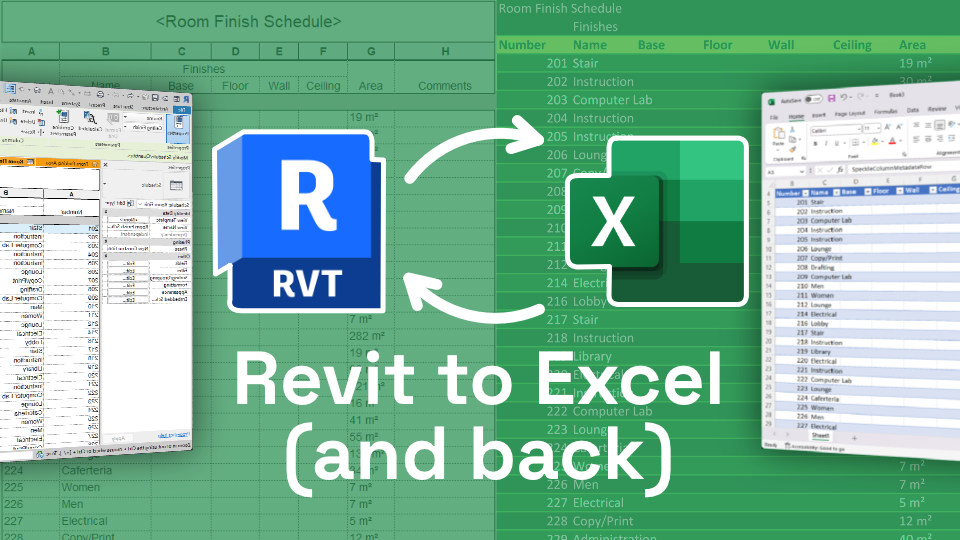Improve Your Operations with Powerful Revit Add Ins
Wiki Article
Excel-to-Revit: A Game-Changing Operations for Architectural Design - Revealing the Tricks
Are you tired of investing hours on building design? Look no more! Introducing excel-to-revit, the game-changing workflow that will certainly transform your style procedure. With excel-to-revit integration, you can simplify your architectural style, unlock efficiency, and optimize partnership within your team. In this article, we will certainly unveil the tricks of this powerful tool, showing you just how it can change your layout jobs. Obtain ready to take your architectural layout to the next degree with excel-to-revit!The Power of Excel-to-Revit Assimilation

Imagine the benefit of having the ability to update and edit task information in Excel, and quickly see those changes shown in your Revit model. No a lot more hands-on information entry or tiresome updates. With Excel-to-Revit assimilation, you can conserve time and lower errors by leveraging the power of Excel's formulas and features to immediately create accurate information in Revit.
Not only does this combination improve performance, yet it likewise improves collaboration amongst staff member. You can conveniently share Excel data with colleagues, who can after that import the information right into their Revit models. This promotes a smooth exchange of info and makes sure that everyone is functioning with the most updated data.

Improving Architectural Style With Excel-To-Revit
Streamlining building design is simplified with using Excel-to-Revit (revit tools). With this powerful combination, you can maximize your operations and save important time throughout the design process. By leveraging the capabilities of Excel and Revit, you can seamlessly move information in between the 2 systems, eliminating the requirement for manual data access and decreasing the threat of errorsExcel-to-Revit allows you to import and export information effortlessly, enabling you to quickly upgrade and customize your architectural designs. You can create schedules, determine amounts, and generate reports in Excel, and afterwards move that data straight into your Revit design. This combination makes certain that your style details is always updated and integrated, removing the requirement for hand-operated updates and lowering the opportunities of inconsistencies.
By utilizing Excel-to-Revit, you can also benefit from the powerful computational capabilities of Excel. You can perform complicated estimations, examine information, and automate repeated tasks, all within Excel. With just a couple of clicks, you can import the results back into Revit, allowing you to make informed design decisions and enhance your building styles.
Unlocking Effectiveness: Checking Out the Excel-to-Revit Operations
Maximize your efficiency by perfectly integrating Excel and Revit for an extra reliable operations. With the Excel-to-Revit process, you can open an entire brand-new degree of performance in your building design procedure. By utilizing the power of Excel's information management capacities and incorporating it with the versatility and accuracy of Revit, you can streamline your design procedure and save useful time.Among the key benefits of this integration is the capacity to import and export data between Excel and Revit. This suggests that you can conveniently transfer task information, such as space schedules or material amounts, from one software to the various other, getting rid of the need for hands-on data entrance and minimizing the possibilities of mistakes. You can likewise produce personalized solutions and estimations in Excel to automate recurring tasks and carry out complicated estimations, which can after that be flawlessly integrated right into your Revit versions.
In Addition, the Excel-to-Revit process enables for better sychronisation and collaboration in between group participants. With Excel functioning as a central information center, several group participants can work with different elements of the project at the same time, sharing and updating information in real-time. This not just improves communication however also ensures that every person is dealing with one of the most up-to-date data, eliminating the risk of inconsistencies.
Making The Most Of Partnership: Excel-to-Revit for Architectural Teams
By perfectly incorporating Excel and Revit, building teams can considerably enhance collaboration and accomplish more efficient design end results. When using this powerful process, you can conveniently move information between Excel spreadsheets and Revit models, enhancing the style procedure and boosting communication among employee. With Excel-to-Revit combination, you can effortlessly import job data, such as space schedules, product amounts, and project criteria, straight right into Revit, removing the demand for manual data entrance and minimizing the chances of errors. This smooth link enables real-time updates, ensuring that everybody is functioning with one look at this now of the most current info and preventing disparities between different records.Additionally, by leveraging Excel's effective calculation capabilities, you can perform intricate calculations and analysis on your style information, offering beneficial understandings and driving educated decision-making. This assimilation additionally enables you to export data from Revit to Excel, enabling you to produce thorough records, graphes, and charts for presentations and evaluation. This joint operations advertises reliable interaction and coordination among employee, as Excel acts as a main center for information monitoring and sharing.
Overall, by embracing the Excel-to-Revit workflow, architectural groups can accomplish greater degrees of collaboration, performance, and accuracy in their design procedure. revit add ins. This assimilation equips teams to work with each other seamlessly, ensuring that every person gets on the very same web page and adding to the success of the task
Revealing the Tricks of Excel-to-Revit Combination

One of the secrets of Excel-to-Revit combination is the capacity to leverage the power of solutions and computations in Excel to drive criteria and produce complex geometries in Revit. You can connect Excel spread sheets to Revit households, permitting you to input data straight into the spread sheet and have it automatically update in the Revit model. This simplifies the style procedure and guarantees precision and uniformity throughout the job.
An additional secret is the capability to develop customized timetables and reports in Excel, making use of data removed from Revit. This permits you to assess and visualize job details in a manner that is not feasible within Revit alone. You can conveniently generate quantity liftoffs, price price quotes, and task timelines, supplying valuable insights for decision-making and project administration.
In enhancement, Excel-to-Revit assimilation makes it possible for efficient partnership amongst employee. Numerous users can work on the same Excel spreadsheet all at once, making it less complicated to coordinate and track changes. You can also use Excel's commenting feature to offer feedback or communicate layout modifications.
Final Thought
By incorporating the power of Excel and Revit, architects can currently function much more efficiently, conserve time, and create much better styles. Beginning including excel-to-revit assimilation into your architectural style procedure today and reinvent the means you work.With simply a couple of clicks, you can import the results back into Revit, allowing you to make informed design decisions and optimize your building layouts.
By utilizing the power of Excel's information monitoring capacities and integrating it with the flexibility and accuracy of Revit, you can enhance your layout procedure and save beneficial time.
By seamlessly incorporating Excel and Revit, architectural teams can greatly boost collaboration and accomplish much more effective layout end results. When using resource this powerful workflow, you can conveniently move data between Excel spread sheets and Revit models, streamlining the style process and boosting find out this here communication among group participants.In addition, by leveraging Excel's effective calculation capacities, you can do complex calculations and evaluation on your design information, offering useful insights and driving notified decision-making.
Report this wiki page